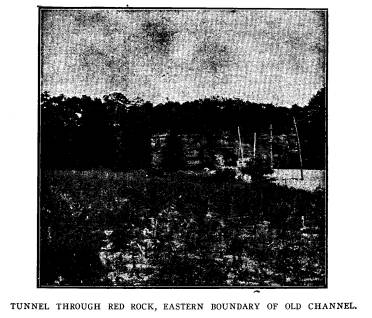Ohio History Journal
The Black Hand. 453
tablet, that was as a guide to their
faith, and then put the hand
on the rock, pointing to the place of
his burial.
THE MINGO CAPTIVE AND THE WYANDOT MAIDEN
AND
THE NEUTRAL GROUND.
H. C. COCHRAN.
An Indian sat at the door of a settler's
cabin and told this
story: Many years ago the red men in the
eastern part of the
state were at war with those in the
middle and northwestern part.
Chief among the former were the Mingos,
and among the latter,
the Wyandots. In one of the stealthy and
bloody incursions
into the Mingo hunting grounds, a young
chief of great promise
was captured and carried back by the
Wyandots. Instead of kill-
ing the young Mingo chieftain, as was
the usual custom, he was
made a serf and compelled to earn the
good-esteem and fellow-
ship of his captors, a fate worse than
death to the young Indian.
The woes of his captivity, however, were
lightened by the kindly
attention of a young Wyandot maiden, the
daughter of the chief
of the tribe into which the Mingo had
been adopted. Genuine af-
fection knows no condition, or it rises
above all environment. The
maiden fell in love with the unfortnate
young chief, and though
watched by the crafty tribesmen, they
made their affection known
to each other and decided to fly to the
Mingo country. One
night they made their escape. At
daylight they were missed
and were pursued by a posse of Wyandots.
The girl had left
behind a tribesman lover, who burning
with the passion of a
disappointed lover, and aching for
vengeance traveled faster
than the couple and overtook them at
Black Hand rock. They
heard the pursuers behind them, knowing
that worse than death
awaited them if captured. With the
stoicism of the savage, they
walked to the edge of the precipice and
surveyed the flood. Fold-
ing the idol of his heart in his arms,
he sprang into the boiling
waters. The pursuers were close enough
to see the last chapter
of the drama. The narrator says the
disappointed pursuers
marked the spot as the Caucasian found
it.
The other legend, one worthy of
perpetuity, is born of the
geology of the country and the trade
conditions of the aboriginees.
|
454 Ohio Arch. and Hist. Society Publications.
About five miles southwest of Black Hand is a great outcrop- ping of chalcedony. The place is known now as "Flint Ridge" and the flint, rare on this continent, was much valued by the In- dians and Mound Builders for making implements of agriculture and war. Like the pipe stone quarries of the Dakotas, where the inimical Sioux and Mandan work side by side in apparent peace, hither the tribes came up, the place being considered sacred to the giver of all good and perfect gifts. For a radius of |
|
|
|
five miles around "Flint Ridge," rested the blessing of the Great Spirit, or that of the orb of day, the divinity worshipped by the Mound Builders. None of the tumult of war was found within that space. Parties in quest of flint, coming to the confines of the charmed circle, laid down their arms for the purpose of mining the necessary stone, for the time forgetting the tradi- tionary hatred of foes. They came from the Mississippi valley, probably by water and debarked from their frail craft at the foot of the rock. The romancer says the spread hand carved on |
The Black Hand. 455
the rock was in mute appeal and forcibly
reminded the wayfarer in
a way at once forcible, as it was
poetical, that thus far and no
farther should the waves of unglutted
vengeance roll. The hand
marked the portal of a sanctuary which
was sacred to the
savage, whose lust for blood rose above
every other considera-
tion in his narrow but intense, isolated
but eventful life.
THE CHIEFTAIN WACOUSTA, THE YOUNG
LAHKOPIS, AND
THE MAIDEN AHYOMAH.
MRS. DAVID GEBHART.
"An unremembered Past
Broods like a presence, midst
These cliffs and hills."
Many moons ago, long before the pale
face came across
the Great Water to this land, here upon
the bank of the Pataskala,
was the lodge of the great chief
Powkongah, whose daughter
Ahyomah was fair as the dawn and
graceful as the swan that
floats on the lake. Her eyes were soft
and shy as the eyes of a
young deer, her voice sweet and low as
the note of the cooing
dove. Two braves were there who looked
upon her with eyes of
love, and each was fain to lead her from
the lodge of her father,
that she might bring light and joy and
contentment to his own.
At last said the chief, her father,
"No longer shall ye contend for
the hand of Ahyomah, my daughter. Go ye
now forth upon the
war path, and when three moons have
passed see that ye come
hither once more, and then I swear by
the Great Spirit that to
him who shall carry at his belt the
greatest number of scalps
shall be given the hand of Ahyomah, my
daughter." Three
months had waxed greater and grown less
ere the warriors re-
turned. Then, upon the day appointed,
behold, all the tribe gath-
ered to view the counting of the scalps.
First stepped forth Wa-
cousta, a grim visaged warrior, who had
long parted company
with fleet-footed youth, and walked
soberly with middle man-
hood. From his belt he took his
trophies, one by one, and laid
them at the feet of the chief, while
from behind the lodge door
Ahyomah, unseen by all, looked fearfully
forth upon the scene.
With each fresh scalp the clouds settled
more and more darkly
